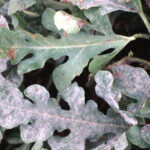Beneficial microbes have been the talk of the town over the past few years, but what are they and how do they work? This post dives into the world of microbial beneficials and what that means for the health of your crops.
What are beneficial bacteria?
Beneficial bacteria are naturally occurring bacteria typically found in the soil. These microbes form symbiotic relationships with the plants in the rhizosphere and are some of the main factors in determining plant health and soil fertility. Soil-borne bacteria are beneficial to plant growth and are commonly referred to as plant growth-promoting rhizobacteria (PGPR). These bacteria promote plant growth by colonizing the plant root (Figure 1). After colonization, there are three main methods of action, including bringing together certain compounds for the plant, helping with the uptake of certain nutrients, such as nitrate from the soil and/or protective properties, including pathogen risk reduction [1].
Figure 1. PGPR colonizes the roots and helps increase the uptake of nutrients to aid in the growth of the plants (https://www.frontiersin.org/files/Articles/565611/fsufs-04-00136-HTML/image_m/fsufs-04-00136-g001.jpg).
What are beneficial fungi?
Fungi in soil have vital roles in keeping your crops healthy. Soil-borne fungi typically live in long strands of cells known as hyphae. They come in many different species, each with specific roles. For example, they can be saprophytes that help break down dead organisms and release the nutrients in the soil. Fungi can also be symbiotic partners that live in the plant’s root zone. Overall these fungi can help plants with water uptake, nutrient cycling, and keeping other pathogens away [2].
How to manage beneficials in your system
Hydroponic systems offer a unique environment for controlling pathogens since growers can manage various parameters (such as temperature, pH, and humidity) to favour beneficial microorganisms and the plant itself. Adding beneficial microbial inoculants can help support the growth of beneficials in hydroponic systems. [3].
Examples of beneficial microorganisms
a. Mycorrhizal fungi
Mycorrhizal fungi are essential in areas where water is sparse, and nutrient density is low as they aid in water uptake. Therefore, they are commonly found in areas with desert-like conditions. Mycorrhizal fungi encourage plants to absorb additional moisture and nutrients and are particularly important to uptake nutrients such as phosphorus. When mycorrhizal fungi are present, plants are less susceptible to water stress because the fungi help build stronger roots so that the plant can uptake more water. Not only do these beneficial fungi help bring water and nutrition into the plant, but they can also store it for the plants when rainfall is sparse and temperatures are high. These mycorrhizal fungi also help the plants resist infection by other fungi and bacteria [4]. Figure 2 shows the difference in root biomass when mycorrhizal fungi are present and when they are not. The plant with larger root biomass usually indicates a more robust and healthier plant overall.
Figure 2. Plants with mycorrhizae will have stronger roots than plants without (https://www2.nau.edu/~gaud/Images/mycoino.jpg)
b. Rhizobacteria
Rhizobacteria are beneficial bacteria found to improve water uptake, nutrient uptake, and stress tolerance in plants [5]. In addition, rhizobacteria can convert fixed nitrogen gas into ammonium; this is the same molecule in ammonium nitrate and ammonium sulphate fertilizers [6]. Plants colonized with rhizobacteria will have noticeable nodules on their roots (Figure 3).
Figure 3. Plant with nodules present on the roots showing the presence of Rhizobia (https://microbewiki.kenyon.edu/images/thumb/a/ab/ZBDYF00Z.jpg/300px-ZBDYF00Z.jpg)
c. Biocontrol techniques using fungi
Biocontrol is the practice of controlling pests by introducing a microorganism that can out-compete or target the biological cause of the problem. Beneficial fungi such as mycorrhizal fungi improve the nutrient uptake of their host plant while also influencing mineral nutrition, water uptake, increasing growth and aiding in disease prevention. In exchange, the fungi need the host plant to grow and reproduce [7]. In addition, beneficial fungi can reduce the risk of infection caused by plant-parasitic nematodes by paralyzing the nematodes [8].
Advantages of Beneficial Bacteria and Fungi
- Help plants uptake nutrients and minerals:
- This helps the plant roots absorb nutrients and minerals more readily and can increase nitrogen fixation in the soil.
- Increase antibiotic-resistance:
- Certain beneficial bacterial species (such as species belonging to the Pseudomonas genus) will have antibiotic properties as they can produce an antibiotic that can help prevent plant diseases [9]. Certain fungi, such as mycorrhizal fungi, can function as an immune booster for soil and plants by producing antibiotics such as polymyxin, difficidin, subtilin and mycobacillin [7].
- Promotes plant growth:
- Certain beneficial fungi such as those in mycorrhizae promote plant growth by optimizing the uptake of nutrients, nitrogen fixation and interactions with other beneficial microorganisms.
How can you increase beneficial bacteria in your system?
- Inoculate your systems:
- Microbial inoculants are living organisms that help your plants grow and can alleviate plant stress. They include bacteria, fungi and microalgae [10].
- Add mulch to your system:
- Adding a layer of mulch in soil systems can help plants grow as it repels the sun’s rays and cools down the soil on hot days. Mulch can also act as a moisture barrier by trapping humidity below the soil surface during the hot summer months [9].
- Utilize probiotics:
- Probiotics are made of live microbes that are beneficial to the plant and act as supplements for the soil and, ultimately, the plant [11].
- Monitor growth of beneficials in your system:
- Keeping track of beneficial microbes in your system will help to see if conditions are optimal for the growth of those bacteria or fungi. This will then give you a good idea of the overall health of your crop.
Beneficial microorganisms occur naturally in the environment and can help plants in terms of antibiotic resistance, increase nutrient uptake and increase water uptake. Overall, this aids in making the plant grower stronger and healthier. Beneficials can also be added to your system to continue improving your plant’s health. Beneficial microorganisms are essential to track as you can increase the beneficials in your system by creating a better growing environment for them.
References:
[1] Hayat, R., Ali, S., Amara, U. et al. Soil beneficial bacteria and their role in plant growth promotion: a review. Ann Microbiol 60, 579–598 (2010). https://doi.org/10.1007/s13213-010-0117-1
[2] THE LIVING SOIL: FUNGI (n.d.). Retrieved August 3, 2022, from https://www.nrcs.usda.gov/wps/portal/nrcs/detailfull/soils/health/biology/?cid=nrcs142p2_053864#:~:text=Along%20with%20bacteria%2C%20fungi%20are,and%20soil%20water%20holding%20capacity.
[3]Beneficial Bacteria and Fungi in Hydroponics | Manic Botanix. (n.d.). Retrieved August 3, 2022, from https://manicbotanix.com/root-disease-prevention-and-management/
[4] Mycorrhizae | Cooperative Extension. (n.d). Retrieved August 4, 2022, from https://www2.nau.edu/~gaud/bio300/mycorrhizae.htm#:~:text=mycorrhizae)%20permits%20the%20plant%20to,major%20nutrients%20required%20by%20plants
[5] Backer, R., Rokem J. S. et al. Plant Growth-Promoting Rhizobacteria: Context, Mechanisms of Action, and Roadmap to Commercialization of Biostimulants for Sustainable Agriculture. Frontiers in Plant Science (9),
[6] Plant-Rhizobia. (n.d.). Retrieved August 7, 2022, from https://www.krugerseed.com/en-us/agronomy-library/plant-rhizobia.html
[7] Bonfante, P., Genre, A. Mechanisms underlying beneficial plant–fungus interactions in mycorrhizal symbiosis. Nat Commun 1, 48 (2010). https://doi.org/10.1038/ncomms1046
[8] Poveda, J., Abril-Urias, P., & Escobar, C. (2020). Biological Control of Plant-Parasitic Nematodes by Filamentous Fungi Inducers of Resistance: Trichoderma, Mycorrhizal and Endophytic Fungi. Frontiers in Microbiology, 11, 992. https://doi.org/10.3389/FMICB.2020.00992/
[9]Sah S, Krishnani S, Singh R. Pseudomonas mediated nutritional and growth promotional activities for sustainable food security. Curr Res Microb Sci. 2021 Nov 24;2:100084. doi: 10.1016/j.crmicr.2021.100084. PMID: 34917993; PMCID: PMC8645841.
[10] Makhaye, G., Mofokeng, M. M., Tesfay, S., Aremu, A. O., van Staden, J., & Amoo, S. O. (2021). Influence of plant biostimulant application on seed germination. Biostimulants for Crops from Seed Germination to Plant Development: A Practical Approach, 109–135. https://doi.org/10.1016/B978-0-12-823048-0.00014-9
[11] 4 Tips for Cultivating Soil Bacteria & Garden Microbes | Smart Pot Blog. (n.d.). Retrieved August 10, 2022, from https://smartpots.com/getting-bac-basics-four-tips-cultivating-soil-bacteria-garden-microbes/
Looking for more useful info? Go back to the Blog Page or checkout the Resources Page.
![]()
Tanya Irani is a Bioinformatician and Agriscience Advisor at Healthy Hydroponics





